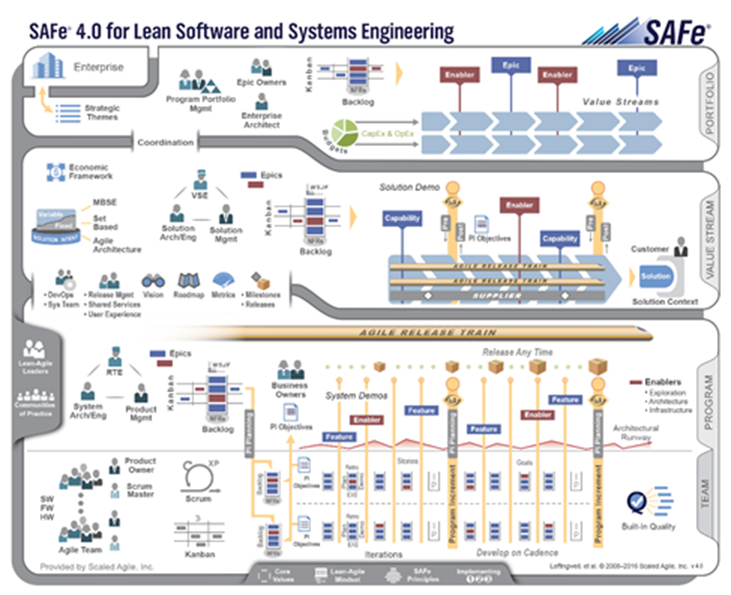GoTo Market strategies are extremely critical and with the time to reach the customer shrinking it is very important for the development and testing teams to deliver a quality product on time.
This paved way for Agile development models and most product and IT organizations are either following Agile or in the process of transitioning to Agile.
Agile experts do find some challenges in acceptance/implementation of Agile models in big enterprises. Most big enterprises consider the implementation in small scale as implementing across big enterprises bring in key some challenges around Program & Portfolio Management & Release Planning
ScaledAgile Framework a brainchild of Dean Leffingwell provides the recipe for adopting Agile at an enterprise level and is illustrated as below – The Big Picture:
 The picture looks complicated, but the structuring is not for control but is for centralizing strategy and decentralizing execution based on SAFe Principles that facilitates effective implementation in an Enterprise. Typically, there are four levels:
The picture looks complicated, but the structuring is not for control but is for centralizing strategy and decentralizing execution based on SAFe Principles that facilitates effective implementation in an Enterprise. Typically, there are four levels:
- Portfolio
- Value
- Program
- Team
Portfolio – in small to midsize enterprise one SAFe portfolio can be used to govern the entire tech solution set. In large enterprise (more than 500 – 1000 Tech practitioners) there can be multiple SAFe portfolios.
Value Stream – intended for builders of large and complex solutions that require multiple ARTs, as well as the contribution of Suppliers. It is intended for enterprises that face the largest systems challenges, building multidisciplinary and cyber-physical systems that contain software, hardware, electrical and electronics, optics, mechanics, fluidics, and more. Not all organizations will need the Value Stream Level
The Team and Program Levels make up the long-lived, self-organizing virtual organization known as the Agile Release Train (ART). Without teams, there can be no program. The ART plans, commits, and executes together. The “Agile Release Train” metaphor is used to communicate several key concepts:
- The train departs the station and arrives at the next destination on a reliable schedule, which provides for fixed cadence, standard ART velocity, and predictable planning (and in many cases, cadence-based releases).
- All “cargo,” including prototypes, models, software, hardware, documentation, etc., goes on the train
SAFe enables tackling tough issues like architecture, integration, funding, governance and roles at scale and is based on Lean & Agile Principles. To facilitate Centralization and Decentralization new program roles like System Team, Program Manager, Release Train Engineer and the likes have been defined in this model.
At WinVinaya we provide Agile related services in helping organizations transition / sustain Agile practices and we have Scaled Agilist on board who can help in the implementation of the Agile practices. If you have a need, please reach out to us at info@WinVinaya.com.
